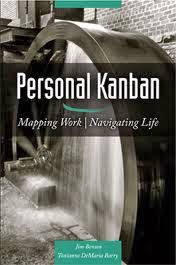A few weeks ago I had a chance to interview Kamal Manglani for Projects at Work. Kamal is an Agile coach who has written a book, The Apprentice and the Project Manager, that was recently released on HappyAbout.
(check out the interview here)
The book includes a narrative based in the past and the present. Stories from earlier work experiences as an apprentice mechanic and current experiences working as a technology project manager are used as a metaphor to explain some key concepts that factor into Agile and Lean.
Explaining an Agile process/framework as a call and response narrative is not a new approach, but what is unique and refreshing about Kamal's book is that in taking a practical approach to getting work done and coping with very specific situations, the author has made a choice to steer clear of promoting one method over another and just kept it to a very pragmatic, straight up approach.
If you are new to Agile and/or Lean, this book would be a great starting place to introduce some of the key concepts without drowning you in jargon and trying to sell you on having found "THE WAY".
When I interviewed Kamal we discussed the book and he mentioned that one of his goals in writing it was to provide a unique perspective on Agility that crossed the boundaries of different areas within an organization (like Quality, Security and Infrastructure) in a way that would make it easy for executives to see how Agile and Lean could help them take advantage of opportunities.
For me, as someone who has spent a lot of time working in both traditional project management and in Agile, my favorite section of this book was the chapter on Financial Health. It is great to see a book for people who lead projects include an easy to understand explanation of why it is so important to factor finance into our decision making process and how to go about doing that in a responsible manner.
You can check out The Apprentice and the Project Manager at HappyAbout.
(check out the interview here)
The book includes a narrative based in the past and the present. Stories from earlier work experiences as an apprentice mechanic and current experiences working as a technology project manager are used as a metaphor to explain some key concepts that factor into Agile and Lean.
Explaining an Agile process/framework as a call and response narrative is not a new approach, but what is unique and refreshing about Kamal's book is that in taking a practical approach to getting work done and coping with very specific situations, the author has made a choice to steer clear of promoting one method over another and just kept it to a very pragmatic, straight up approach.
 |
| Author: Kamal Manglani |
When I interviewed Kamal we discussed the book and he mentioned that one of his goals in writing it was to provide a unique perspective on Agility that crossed the boundaries of different areas within an organization (like Quality, Security and Infrastructure) in a way that would make it easy for executives to see how Agile and Lean could help them take advantage of opportunities.
For me, as someone who has spent a lot of time working in both traditional project management and in Agile, my favorite section of this book was the chapter on Financial Health. It is great to see a book for people who lead projects include an easy to understand explanation of why it is so important to factor finance into our decision making process and how to go about doing that in a responsible manner.
You can check out The Apprentice and the Project Manager at HappyAbout.


